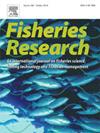Using angler-submitted records to interpret the spatial seasonality of a large predator (Black bass, Micropterus spp.)
IF 2.3
2区 农林科学
Q2 FISHERIES
引用次数: 0
Abstract
In addition to having cultural, social, and economic significance, large predatory fish affect aquatic communities from the top down and serve as markers of ecosystem health. A focus on large predators is critical for managing ecosystems, conserving species, and guaranteeing the sustainability of aquatic resources. Recreational fishing is inherently biased towards large fish, and anglers possess the strength in numbers and geographical dispersion that enable them to sample the upper tiers of size distributions rarely encountered in standard fish surveys. We sought to further understand the ecological requirements and spatial seasonality of exceptionally sized black bass (Micropterus spp.) via angler catches. Black bass > 3.6 kg were examined across 147 reservoirs in Texas, USA, with 2817 fish recorded by anglers into an online database in 2018–2024. Most fish were caught in late-winter and early-spring in line with spawning activities that included movements in-and-out of shallow water, nest building, and nest defense. Approximately 54 % of fish were caught with bottom-oriented fishing lures and techniques, and 40 % midwater; surface catches were less common. The efficacy of angling techniques varied seasonally. Those effective in winter were midwater, while those effective in summer were bottom or surface. Conversely, a combination of bottom and midwater techniques were effective in the fall and spring, suggesting cyclic habitat transitions. Moreover, the frequency with which fish were caught over various macrohabitats varied seasonally and cyclically. Our findings have the potential to inform habitat management that supports large predators and their migratory relocations. Our findings also underscore the value of using anglers and technology as sources of difficult-to-obtain fish and environmental data that may evade regular monitoring.
利用垂钓者提交的记录来解释大型捕食者(黑鲈鱼,小翅鱼)的空间季节性。
除了具有文化、社会和经济意义外,大型掠食性鱼类还从上到下影响水生群落,并作为生态系统健康的标志。关注大型捕食者对于管理生态系统、保护物种和保证水生资源的可持续性至关重要。休闲垂钓固有地偏向于大鱼,垂钓者在数量和地理分布上都有优势,使他们能够在标准鱼类调查中很少遇到的大小分布的上层取样。我们试图通过垂钓者的捕捞进一步了解特大黑鲈鱼(Micropterus spp.)的生态需求和空间季节性。在美国德克萨斯州的147个水库中对黑鲈鱼>; 3.6 kg进行了检查,垂钓者在2018-2024年期间将2817条鱼记录到在线数据库中。大多数鱼在冬末和早春捕获,这与产卵活动一致,包括进出浅水,筑巢和筑巢。大约54% %的鱼是用底部导向的鱼饵和技术捕获的,40% %是在水中捕获的;水面捕获较少。钓鱼技术的效果随季节而变化。冬季有效的是水体中部,夏季有效的是水体底部和水面。相反,底部和中水技术的组合在秋季和春季是有效的,这表明周期性的栖息地转换。此外,各种大型生境的渔获频率随季节和周期而变化。我们的发现有可能为栖息地管理提供信息,以支持大型捕食者及其迁徙重新安置。我们的研究结果还强调了利用垂钓者和技术作为难以获得的鱼类和环境数据来源的价值,这些数据可能会逃避定期监测。
本文章由计算机程序翻译,如有差异,请以英文原文为准。
求助全文
约1分钟内获得全文
求助全文
来源期刊

Fisheries Research
农林科学-渔业
CiteScore
4.50
自引率
16.70%
发文量
294
审稿时长
15 weeks
期刊介绍:
This journal provides an international forum for the publication of papers in the areas of fisheries science, fishing technology, fisheries management and relevant socio-economics. The scope covers fisheries in salt, brackish and freshwater systems, and all aspects of associated ecology, environmental aspects of fisheries, and economics. Both theoretical and practical papers are acceptable, including laboratory and field experimental studies relevant to fisheries. Papers on the conservation of exploitable living resources are welcome. Review and Viewpoint articles are also published. As the specified areas inevitably impinge on and interrelate with each other, the approach of the journal is multidisciplinary, and authors are encouraged to emphasise the relevance of their own work to that of other disciplines. The journal is intended for fisheries scientists, biological oceanographers, gear technologists, economists, managers, administrators, policy makers and legislators.
 求助内容:
求助内容: 应助结果提醒方式:
应助结果提醒方式:


